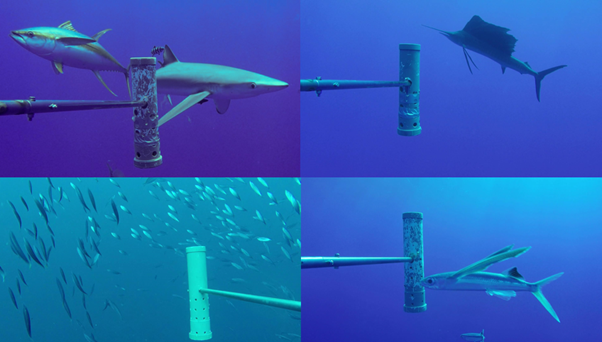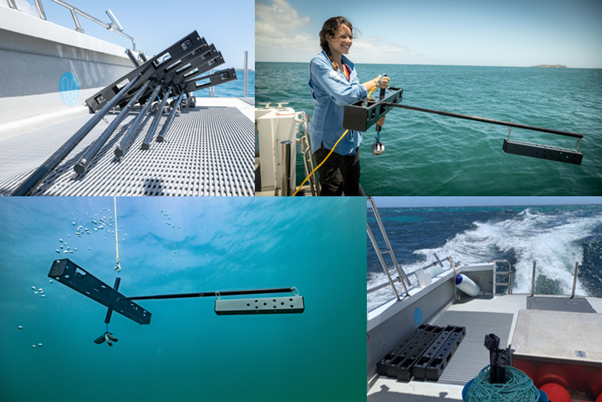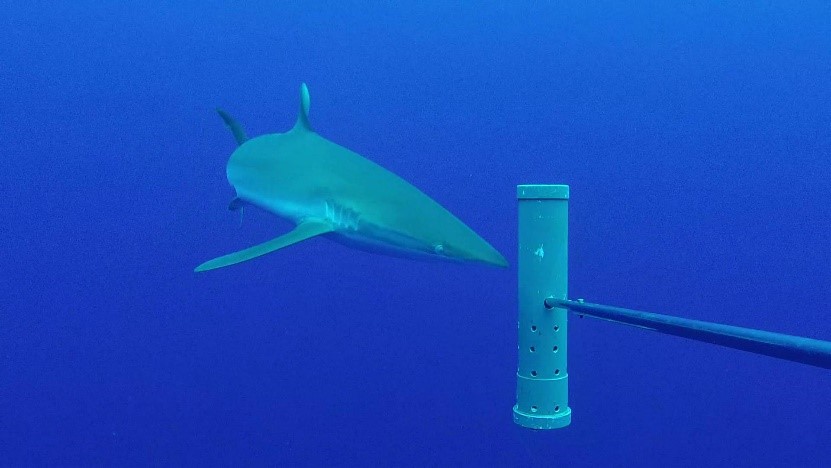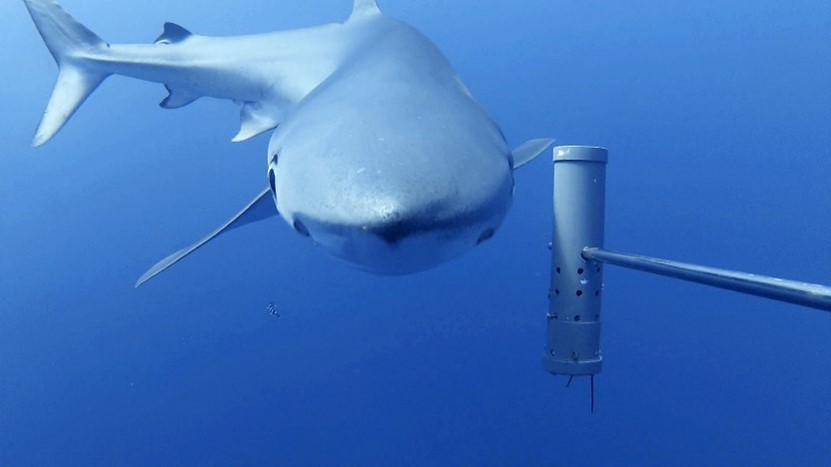Cefas project lead, Dr Paul Whomersley: The oceans are rich and wondrous, hosting diverse wildlife and incredible species beneath the surface. But at a time when ocean resilience and productivity are declining, it is more important than ever to look beneath the surface of this “blue curtain” and better understand what lives below.
Cefas scientists are working with our partner Blue Abacus and the UK Overseas Territories (UKOTs) on an international underwater camera network that aims to increase our knowledge of and support the protection of wildlife and biodiversity around the UKOTs. The Global Ocean Wildlife Analysis Network, which is part of the Blue Belt programme will help provide the evidence needed to monitor and sustainably manage the UKOTs significant marine areas across the Atlantic, Indian, Pacific and Southern Oceans.
As the Global Ocean Wildlife Analysis Network prepares to launch, Professor Jessica Meeuwig, co-founder of Blue Abacus, joins us for a guest blog explaining more about the network, equipment and how it will support UKOTs to observe and manage ocean wildlife in their diverse ecosystems.
Dr. Jessica Meeuwig, Co-founder Blue Abacus and Professor University of Western Australia:
Ten British Overseas Territories are establishing a new network to document the status of their open ocean wildlife and build ocean resilience.

As part of the UK’s Blue Belt programme, supported by the Centre for Environment, Fisheries and Aquaculture Science (Cefas) and the Foreign, Commonwealth and Development Office (FCDO), UK Overseas Territories (UKOTs) will now have additional equipment and support to improve their knowledge and understanding of the wildlife that inhabits both their open ocean and coastal habitats. The Global Ocean Wildlife Analysis Network will enable us to work with UK Overseas Territories and our project partners to draw back the blue curtain and learn more about the wildlife which lives below.
The pelagic fish (meaning those which live in the middle and upper sections of the water column) in these open ocean habitats include threatened species such as oceanic sharks, tunas, billfishes and forage species, almost all of which are declining globally.
Counting pelagic fish in the open ocean is challenging because fish are not like trees that you can identify and measure as you walk through a forest. Fish are literally hidden beneath the blue curtain of the ocean’s surface, elusive in a vast and remote habitat. At best, we have a poor understanding of which species are where, how many there are, and how big they are.
Despite the challenge, accurately counting pelagic fish is important because pelagic fish are the base of resilient oceans and support our blue economy. More than 80% of our seafood is derived from pelagic fisheries, 100s of millions of livelihoods depend on fishing, and resilient oceans mitigate climate impacts. The new network will help to fill that evidence gap, using new equipment and techniques to collect more data to build a fuller understanding of ocean ecosystems.
A fish-eye’s view beneath the surface:
The Overseas Territories are embarking on their fish counting programmes using mid-water stereo Baited Remote Underwater Video Systems (BRUVS), working in partnership with UK Government Blue Belt programme and Blue Abacus who have developed the new units. BRUVS, long used in shallow reef systems, have now been adapted to open ocean environments. For the first time, we can get a fish-eye view on the entire pelagic fish community… without killing them.
BRUVS consist of two small action cameras (‘stereo’ view) set in a cutting-edge carbon fibre frame that is light-weight, robust and easily deployed from the back deck of both small and large boats. The mid-water BRUVS being installed for the Global Ocean Wildlife Analysis Network are deployed in a long-line configuration with five rigs, each separated by 200m of line, drifting in the open ocean for a two-hour soak. The BRUVS are then recovered, re-baited and redeployed. At the end of the field day, the camera SD cards are removed and the video files are downloaded for analysis.
Video analysis provides key information on what species are present, how many there are and the size of recorded individuals. Size is particularly important as it tells us about the reproductive potential of the populations, with old large females some of the most important individuals in the ocean. An important sign of population recovery is that the average size of fish increases!

How does counting fish help?
Documenting pelagic fish species, their distributions and how they change supports ocean management in a number of ways.
Marine protected areas build ocean resilience. The UK Government has committed to the call for 30% of the ocean to be protected by 2030 (the 30x30 initiative). Data on pelagic fishes can help decision-makers identify where protection should be implemented, determine what level of protection should be established and then, through time, evaluate the benefits of this protection and adjust it as appropriate.
BRUVS data also provide a standard measure of the status of pelagic wildlife that fundamentally tells us whether fish populations are in decline or in recovery. Such fisheries-independent data are important complements to conventional stock assessments, and provide valuable information on the many migratory species of pelagic fish that move around a large region and do not restrict themselves to one country’s maritime zone. This data can also assist in management of data-poor fisheries and in improving our understanding of bycaught species for which fisheries-derived data are typically inadequate.
The permanent video records generated by BRUVS also provide all of us with a glimpse beneath the blue curtain. The video allows the community to better understand the beauty and richness of their backyard ocean biodiversity – from stately billfish to inquisitive shark pups.
What have BRUVS found so far?
To date mid-water BRUVS have identified, counted and measured more than 135,000 pelagic fish and sharks from more than 30 locations, including the UK Overseas Territories of BIOT, Ascension Island and Tristan da Cunha.

In BIOT, we have uncovered the importance of hitherto unknown seamounts in supporting the Critically Endangered scalloped hammerhead shark and the ongoing poaching challenges faced by other sharks in BIOT.

At Ascension Island, seamounts were clearly identified as biodiversity hotspots but roaming species like blue sharks, one of the most heavily exploited sharks globally, were most strongly associated with open ocean areas. This is strong evidence for the need for large-scale protection rather than only localised protection at physical features like seamounts.

In Tristan da Cunha, surveying from the main island to the southern reaches, we documented the tremendous productivity of the green sub-Antarctic waters. With the first underwater sighting of the elusive Shepherd’s beaked whale at the appropriately-named Inaccessible Island, footage from Tristan da Cunha also demonstrates its importance as a refuge for rare and at-risk species. The Tristan da Cunha EEZ is also an important refuge for blue sharks as pups and females were in the highest abundances of any of our global sites.

Plans for 2021
Over the next few months, complete sets of stereo-BRUVS and associated equipment will be delivered to the UK Overseas Territories. Planning for new surveys is commencing: for some OTs this will build on existing BRUVS surveys but for others, their Big Blue is being unveiled for the first time.
Cefas project lead, Dr Paul Whomersley:
Sub surface video equipment such as that being used in the Global Ocean Wildlife Analysis Network offer another method of collecting evidence vital to the protection and sustainable management of our marine systems and resources. The data collected will increase our knowledge of what species exist within the mysterious pelagic realm and help us understand how they utilise the vast areas of open ocean. We are extremely excited to see what we and our partners in the UKOTs, the Foreign, Commonwealth and Development Office and Blue Abacus discover.
For more information as the network develops, follow Blue Belt on twitter, Blue Abacus on twitter, Instagram and LinkedIn and the Marine Science blog.